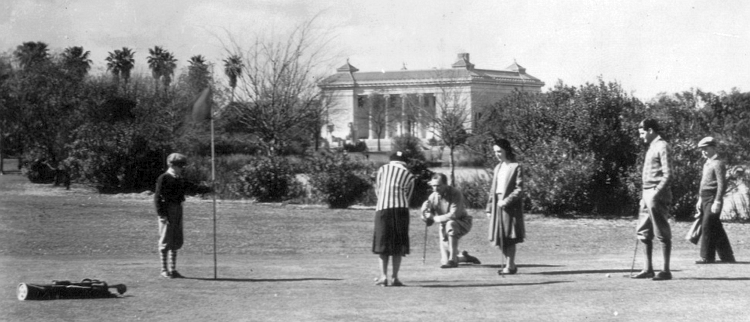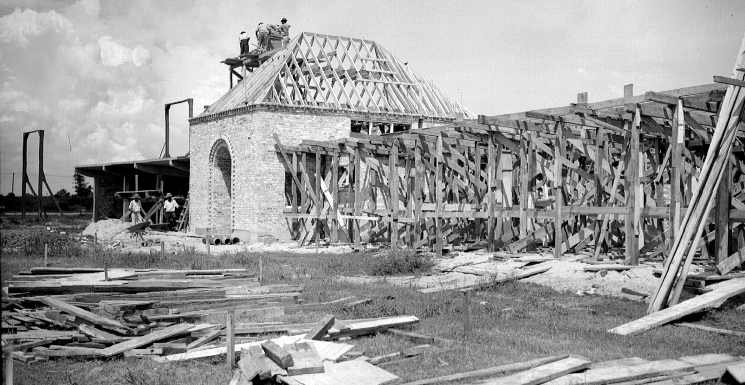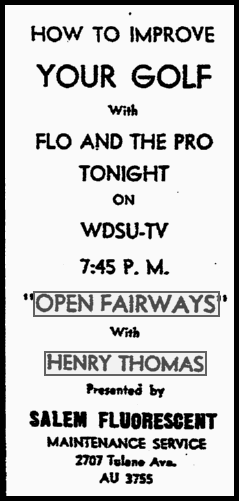|
Today in New Orleans History |
|
|
June 30


 Henry Thomas, "Mr. Golf" in New Orleans “In Lieu Of Flowers, Please Make Donations To Rebuild City Park Golf Course” requested
the Times-Picayune obituary for Francis Henry Thomas who died on December 2, 2005 in Houston months after post-Katrina federal
flood-wall breaks caused ruin to park's courses and displaced him, his wife Romy, and hundreds of thousands of other New Orleanians.
Thomas had dedicated more than half of his 94 years to caring for and expanding City Park's golf offerings into one
of the largest facilities in the country. He came to be known as "Mr. Golf" to local adherents of the sport.
Henry Thomas began working, in 1920, as a caddy at the park when he was 9 years old. He carried Babe
Ruth's clubs when the Yankees trained in New Orleans. In 1929, Thomas became a pro at age 18 and in 1930 he became an assistant
at City Park. He then moved to Colonial Country Club in Harahan until 1933 when he returned as head pro at City Park
when golf facilities included a mere 9-hole course abutting the McFadden mansion (now Christian Brothers School) and property.
Thomas remembered the "Black Cat", a depression era speakeasy on the 13th hole near Bayou
St. John, where golfers stopped for a home-brew -- many of them then failing to complete the remaining holes. During
the 1930s he organized a Christmas Holiday Tournament which evolved into the New Orleans Open, which he was instrumental
in organizing and served twice as its chairman. In 1933 he organized free weekly lessons for children age 5 through
14 which continued for decades and introduced generations of New Orleanians to the sport. The program grew to include
as many as 200 teachers, many of whom he had taught. A good number of his students became golf professionals, including
the man who would replace him when he retired. During Thomas' tenure the following improvements were
completed: A new nine hole golf course completed in 1937, which added nine holes to the original course.
It ran along Bayou St. John, surrounded the McFadden property, and continued north of Art Museum. The WPA caption
for the 1930s photograph above reads "Golf the Year Round. This course, in beautiful City Park, is one of the six evergreen
golf courses in New Orleans on which play is continuous the year round”. The old St. John's golf clubhouse
was remodelled at this time and was surrounded by additional structures which contained a lobby, lounge, display shop, men's
and women's locker rooms (increased from 75 to 250 lockers), and a caddy house accommodating 300 caddies with a sound system
connecting with the club house and a bulletin board maintained to display current news on golfing events throughout the
country, and an outdoor recreational area – all at a cost of $85,000. For the 1938 New Orleans Open PGA Golf Tournament
Mayor Robert S. Maestri donated $5000 in prize money – then $10,000 per year until 1941 when dentist Herbert H. Meyer
donated $5,000. The 1938 event attracted 10,000 spectators. The Crescent City Open in 1938 was won by Lloyd Mangrum who
bested Sam Snead and Lawson Little. The park hosted the Open until 1962. 1969 brought the addition of the 18-hole North Course and another club house -- Mayor Victor
Schiro was the first to tee off. That year the 15,000 square-foot "Henry Thomas' Golf Shop" in the park at
1040 Filmore Street took in $6,500 in gloves sales alone (5% of the total volume of the shop, at which Mrs. Romy Thomas, his
wife, worked). The Greater New Orleans Sports Hall of Fame inducted Henry Thomas in 1977.
In 1984 Friends of City Park named a tournament for him. Golfers played 250,000 rounds of golf at City Park that
year. In 1986 he asked that his contract be extended for another two years, which the City Park commissioners approved, but
in 1988 they decided that it was time for him to retire.  

To receive an update for each day in New Orleans
history, join our facebook page
- Today in New Orleans History
Tweet
|
|
|

To receive an update for each day in New Orleans history,
join our facebook page - Today in New
Orleans History.
Analytics |

 The driving range is under construction in this 1938 view (left). WPA notes for this photograph are, “It will have
an administrative building which will contain lockers and dressing rooms; refreshment room; six stalls, each of which will
be 18 feet wide. The field will be equipped with four batteries of flood lights”.
The driving range is under construction in this 1938 view (left). WPA notes for this photograph are, “It will have
an administrative building which will contain lockers and dressing rooms; refreshment room; six stalls, each of which will
be 18 feet wide. The field will be equipped with four batteries of flood lights”.  In 1940, Thomas inaugurated an annual tournament for juveniles. In 1942, he created a club for working women golfers,
Beginning in the 1940s, he began visiting Carville Leprosarium twice each month to teach doctors and patients, and continued
to do so until the 1980s.
In 1940, Thomas inaugurated an annual tournament for juveniles. In 1942, he created a club for working women golfers,
Beginning in the 1940s, he began visiting Carville Leprosarium twice each month to teach doctors and patients, and continued
to do so until the 1980s. 
